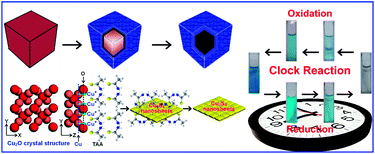Ultrathin Cu7S4 nanosheets-constructed hierarchical hollow cubic cages: one-step synthesis based on Kirkendall effect and catalysis property†
Abstract
Ultrathin two-dimensional (2D) nanosheets are a conceptually new category of nanoscale materials. Integration/assembly of individual 2D nanosheets into 3D hierarchical structures is an enormous challenge and an essential requirement for their application. Here we first report the direct synthesis of Cu7S4 hierarchical hollow cubic cages assembled by ultrathin nanosheets based on the Kirkendall effect. Slowly released Cu+ from Cu2O cubic template-crystals and S2− from decomposed thioacetamide (TAA) can react with each other and form a diffusion pair, which provides a thermodynamic and kinetic equilibrium to be responsible for the formation of ultrathin Cu7S4 nanosheets and the Cu7S4 hierarchical hollow cubic cages. Using this unique hollow structure and the outstanding catalytic property of the Cu7S4 nanosheets, as an example, we successfully demonstrate that Cu7S4 nanocages can effectively catalyse the “clock reaction”, which is a periodic cycle redox oscillation reaction between methylene blue (MB) and colorless leucomethylene blue (LMB). The unique hierarchical structure has been found to enhance the rate of this redox reaction via the ultrathin nanocatalyst. This work develops a facile strategy for synthesizing 3D hierarchical structures constructed by ultrathin nanosheets and demonstrates their superior ability to optimize the nanosheet-catalyzed clock reaction.


 Please wait while we load your content...
Please wait while we load your content...